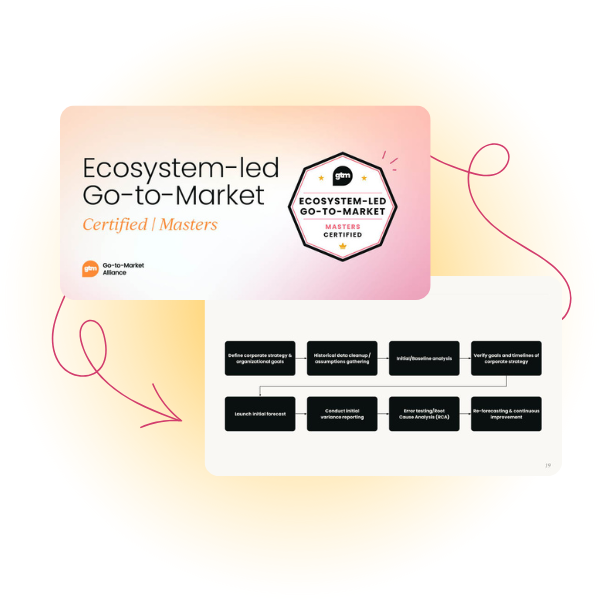This article is adapted from Angelique Kamara’s presentation at our sister community Revenue Operations Alliance's Chief Revenue Officer Summit in San Francisco.
As a VP of Partnerships, I've learned that partner-led growth isn't just a strategy – it's a comprehensive approach to scaling your business.
Let me share the insights I've gathered through years of building successful partnership ecosystems. I’ll cover:
- Why partnerships matter
- The partnership mindset
- Tips for before you start
- 3 steps to craft your partnership strategy
Why partnerships matter
Before we discuss how to implement partner-led growth, it’s important to understand why this motion is important for revenue growth. Here are some statistics from recent research into partnerships:
Customer retention
We've discovered something fascinating: when customers use multiple integrations with your product, their likelihood of churning drops by 58%.
This typically happens when customers have three or more integrations. It's an intuitive phenomenon – the more deeply your product is integrated into a customer's tech stack, the harder it becomes to replace.
Think about it like building layers of connection.
Each integration is another thread that ties the customer more closely to your solution. As these integrations accumulate, you're essentially creating a complex web that makes switching providers increasingly difficult and less attractive.
Win rates and deal velocity
But retention is just the beginning. When it comes to sales, partnerships deliver even more impressive results.
Bringing a partner into a deal (especially for long, complex sales cycles) can boost your win rates by an aggregate of 53%. Even more impressive, these partner-involved deals close 46% faster.
This is a testament to the power of strategic partnerships.
Each integration isn't just a technical connection. It's a value-added relationship that makes your solution more sticky, compelling, and successful.

The partnership mindset
The one thing I want you to remember is this:
Partnerships are a company strategy, not a department.
As a VP of Partnerships, I've seen many companies make one critical mistake: They hire a partnerships leader, stick them in a silo, and assume the job's done.
That approach is doomed to fail. True partnership success requires integration across every function.
This means getting buy-in and support from multiple stakeholders:
- Product teams need to build features and capabilities that support your partners
- Marketing teams should leverage partnerships to help scale your reach
- Customer success and sales teams must be aligned to provide comprehensive partner support
The goal is to create a holistic approach where every department understands and contributes to the partnership strategy. It's not just about one team – it's about creating a unified, collaborative environment that maximizes the potential of your partnerships.

Before you get started
While you might be tempted to jump straight into partner-led growth strategies, it’s important to ensure you lay the groundwork for success. This section discusses the best practices to prepare your organization for a partnership motion.
Where partnerships should live
Before building a partnerships team, consider a crucial question: Where should partnerships report?
There's no one-size-fits-all answer.
Some argue partnerships should report to the CEO, especially for early-stage or strategic alliance-focused companies. But ideally, the reporting structure should match your partnership goals:
- Brand awareness focus: Report to the Chief Marketing Officer
- Product integration goals: Report to the Chief Product Officer
- Revenue acceleration: Report to the Chief Revenue Officer
The partnership value exchange
Here's a critical insight: Partnerships are not sales. They're a bilateral relationship with genuine value exchange.
Consider the Salesforce model: For every dollar of software they sell, their ecosystem generates $7 in services. While you don't need to match that exact ratio, the principle is crucial – be intentional about the value you bring.
As a counter-example: Say you're excited about agency partnerships as they could drive referrals and traffic to your org. But if your product is super easy to implement and you have a robust customer success team, your agency partners won't gain much value from that partnership.
They can't:
- Build additional services on your platform
- Generate significant revenue
- Get excited about small referral fees
So it’s important to select your partners wisely and consider the value exchange. What do you gain, and what does your partner gain?

Partner operations
When building a partnerships team, it's crucial to approach it strategically, just like you would with a sales team. You wouldn't create a sales team without a CRM or revenue operations team.
Similarly, don't launch a partnership program without a solid system for tracking and measuring partner metrics.
These metrics don't necessarily need to be in a separate system—they can integrate with your existing sales processes. The key is to be intentional about how you'll measure success and track partnership performance.
Crafting your partnership strategy
Now that you’ve set up the foundation of partner-led GTM in your organization, you can start to craft your strategy. Here are the three steps to ensure a successful partnership:
1. Understand your company's north star
When developing a partnership strategy, I always start by deeply understanding the company's core opportunity and North Star. The key is to ensure your partnership approach directly supports the broader company vision.
The process typically involves a few critical steps:
First, get crystal clear on the company's strategic direction. This means understanding:
- Total market opportunity
- Ideal customer profile
- Current market share
- Growth projections
- Key geographic markets and customer segments
Always try to understand the long-term plan, even if you don't have the full details mapped out. This gives you insight into where partnerships can truly add value.
Your partnerships should do one of two things:
- Accelerate existing plans, or
- Introduce complementary investments the company hadn't previously considered.
By putting your organization's North Star first, you can focus on creating partnerships that genuinely move the needle for your organization.

2. Identify partner types and go-to-market motions
Partnerships fundamentally break down into two primary categories: technology partners who sell products or software, and service partners who provide professional services.
Once you've identified the type of partner, you'll need to choose a go-to-market approach depending on how deeply you want to collaborate with your partners.
I see three primary levels of partnership engagement:
- Referral: Basic customer exchanges and lightweight integrations, essentially just sending customers back and forth.
- Co-selling: Collaborative sales efforts with joint account mapping and combined GTM efforts.
- Reseller: Partners managing the entire customer relationship.
The beauty is you can mix and match these go-to-market approaches with different partner types. Each motion comes with its own set of challenges and requirements, but this framework provides a straightforward way to think about building meaningful partnerships.
The key is understanding which approach best serves your specific business goals and partner ecosystem.

3. Prioritize
Prioritization is where most partnership strategies live or die.
You'll inevitably have more opportunities than you can effectively activate, so you must be ruthlessly selective.
Use a framework that evaluates potential partnerships based on impact versus cost and feasibility. I like using a SWOT analysis to easily identify the strengths, weaknesses, opportunities, and threats of a partnership opportunity.
Then tackle projects as follows:
- Focus on high-impact, low-cost opportunities first.
- Then develop foundational steps and timelines for high-impact but complex partnerships.
- Avoid low-impact, high-cost initiatives entirely.
Throughout this process, maintain clear alignment with your company's leadership, track meaningful metrics like budget achievement and net dollar retention, and remain flexible.
A great partnership strategy isn't about doing everything—it's about strategically choosing the right partnerships that propel your company's growth and complement its core objectives.

Aligning internal partnerships
As I mentioned earlier, partnerships aren’t just external. You also have to ensure alignment within your internal teams to succeed. This involves ensuring sales, marketing, customer success, and product teams are all on the same page.
A simple way to achieve this is by utilizing the four dimensions of building trust and alignment:
- Roles: Clear responsibilities and handoffs.
- Goals: Aligned, cascading objectives.
- Trust: Credibility, reliability, intimacy, low self-orientation.
- Processes: Right tools and communication mechanisms.
The ultimate aim should be to create a seamless, integrated approach where partnerships aren't a separate function, but a core company strategy.
Final thoughts
Partnerships aren't just a channel—they're a strategic growth lever.
By treating partners as an extension of your team and creating genuine, mutually beneficial relationships, you can unlock exponential growth potential.
The most successful companies don't just have partner programs. They have partner ecosystems.
Forge industry alliances and become unbeatable
Looking for the full, actionable low-down on building partnership strategies?
Sign up to Ecosystem Go-to-Market: Masters and Reach new audiences, amplify your messaging, and finally sell at scale when you learn how to leverage strategic partnerships the right way.











